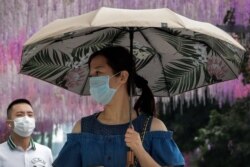The coronavirus is reemerging in Asian countries previously praised as models of containment, underscoring the resilience of the virus and dealing a blow to the idea of so-called travel bubbles between countries seen as safe zones.
Vietnam, Hong Kong, Australia, and Japan have all seen the virus spread faster than ever this month, raising the prospect of a return to extended lockdowns. Mainland China, where the virus originated, has also seen a spike in cases.
Some of those countries had been part of discussions about travel bubbles, which were proposed early in the pandemic as a way to reinvigorate economies by reopening quarantine-free tourist and international business travel. But with the new wave of infections, even many proponents of travel bubbles are acknowledging the idea is unrealistic for now.
“It's just a real mess,” says Ken Atkinson, vice chairman of the Vietnam Tourism Advisory Board, which has lobbied the Vietnamese government to consider the travel bubbles. “I think we're looking at some time into next year before we can really see non-quarantine travel from anywhere.”
Vietnam resurgence
To understand the difficulty of eradicating the coronavirus, look no further than Vietnam. Until this week, the country of 95 million people had reported only around 450 cases and zero deaths, thanks to its rapid quarantine measures and rigorous contact tracing.
Vietnam had gone nearly 100 days without seeing a local infection - a stunning accomplishment for a country that shares a long border with China. But even that sustained success wasn't enough to prevent a COVID-19 resurgence.
Over the past week, Vietnam has reported 93 new cases as part of a wave of infections traced to the central city of Danang. Authorities have since evacuated 80,000 people, mostly local tourists, and suspended flights to and from the popular resort city, parts of which now resemble a ghost town.
In Hanoi, Vietnam's capital, bars and nightclubs have been closed and large gatherings banned. Many of the country's beaches that had been filled with local tourists now sit empty.
“We have several drivers and tour guides and they are at home without work,” says Marcel Renes, who owns the Ninh Binh Tourist Center that offers tours and private drivers in the Hong River Delta in northern Vietnam.
With Vietnam’s borders sealed for months, many hotels, resorts, and other parts of the tourist industry had switched their focus to attracting locals rather than foreigners. But the latest outbreak has endangered even that.
“I have no idea what we can do now,” Renes says. “The borders are still closed, and I think for the next six months they will remain closed.”
The source of Vietnam's outbreak isn't clear. Since the new cases were discovered, Vietnam has cracked down on illegal immigration from China, although authorities have not linked any of the cases to unauthorized border crossings.
Business travel blamed in Hong Kong
Hong Kong is also experiencing a new wave of infections, after having not reported a locally transmitted case for three weeks. For the past nine days, Hong Kong has reported over 100 new cases per day
The Chinese territory, whose economy relies on international business travel, has allowed certain categories of inboard travelers - including some executives, airline staff, and government officials - to be exempt from various quarantine rules.
Over 290,000 people have been given such exemptions since February, according to official figures. Health authorities now acknowledge those exemptions may be at least partly to blame for the virus resurgence.
China, Japan, Australia
Mainland China for a time was the epicenter of the global pandemic, but quickly contained the virus using some of the world’s most draconian measures, including walling off an entire province for months.
But even those steps couldn’t stop the virus from returning. New daily coronavirus cases in China surpassed 100 for the first time since mid-April. Most of the new infections have been in the northwest region of Xinjiang, posing a new threat for the masses of Uighur Muslims that have been sent to internment camps.
China closed its borders to almost all foreigners in late March and had only slowly begun relaxing some of those restrictions on a country-by-country basis.
Japan has also reported record high numbers of cases this week, surpassing 1,000 new daily infections for the first time. Officials have warned another state of emergency could be declared in major urban centers such as Tokyo.
In Australia, a surge of infections has been centered in Victoria, the country's second most populated state. Australia saw its deadliest day Thursday, reporting at least 13 deaths and more than 700 new infections.
The Australian infections have further delayed a quarantine-free travel arrangement with New Zealand - a deal that many once hoped would become one of the world’s first travel bubbles.
New Zealand is now one very few countries to have seemingly eradicated the coronavirus - and kept it that way. Other regional successes include South Korea, Taiwan, and Thailand. But it’s a short list that seems to be getting shorter every week.
Years not months
As long as many parts of the world continue to see locally spreading infections, widespread international travel will be “pretty much impossible until a vaccine is found,” says Archie Clements, an epidemiologist at Curtin University in Perth, Australia.
“We will be dealing with this for quite some time,” predicts Clements. “I think we're talking multiple years rather than months before we can resume international travel in a fairly contained way.”
But in the meantime, international travel will continue in many countries, even if it is more expensive. Travelers now must now consider the cost of pricier airline tickets, mandatory coronavirus tests, and potentially an enforced weeks-long quarantine stay.
“You’ve got to pay the cost of a two-week quarantine in a hotel...who can afford to do that?” says Sharon Friel, who focuses on health equity and governance at the Australian National University.
That dynamic, Friel says, could result in a throwback to the class divide of the 1950s, when only wealthier individuals could afford to travel overseas.
“It will be people with money,” she says, “that will be doing any sorts of international travel.”










